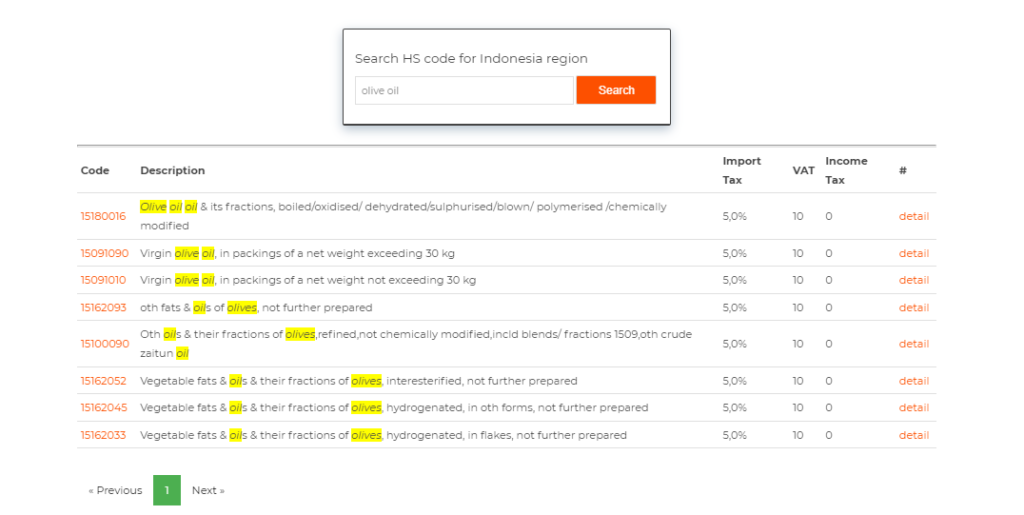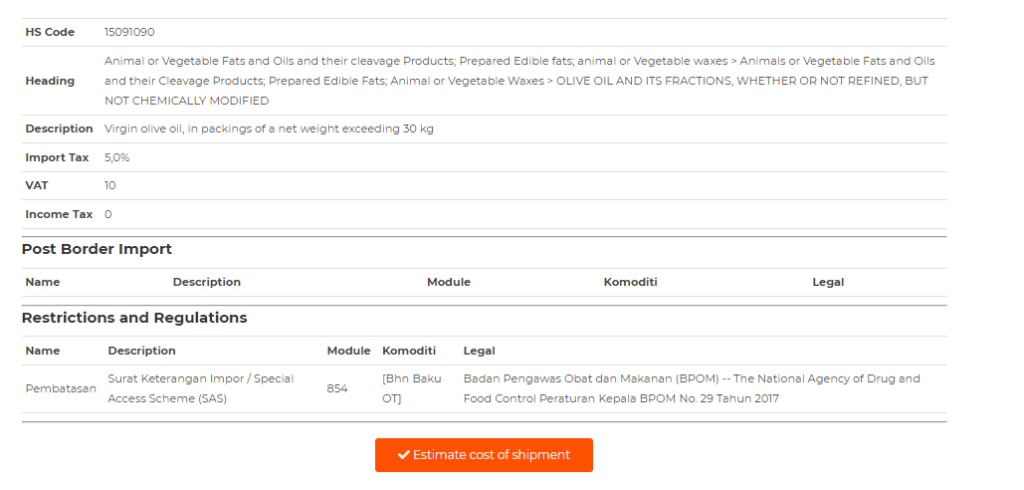How to Import Olive Oil to Indonesia?
You are here:
- Home
- Export Import
- How to Import Olive Oil…
Who does not know olive oil? The oil extracted from olive fruit has many benefits and uses. In Indonesia, they use imported olive oil for many beauty and food products. In this article, we will talk about how to import olive oil to Indonesia.
In Indonesia, people use olive oil in many products. Both as a cooking oil and as an ingredient for beauty care.
In general, olive oil is available in five main types. These are extra virgin olive oil, pomace olive oil, virgin olive oil, refined olive oil, light olive oil, and extra light olive oil.
These types of olive oil are distinguished by their quality. Cold-pressed oils like extra virgin olive oil are indeed the most expensive. It is usually used as a salad blend or as a cosmetic blend.
Meanwhile, people use other below-grade types of olive oil as cooking oil.

As of 2019, the Indonesian government has officially abolished the imposition of import duties on dates and olive oil products from Palestine.
This is because of the minimal production of olive oil in Indonesia. In fact, Olive fruit is hard to grow in Indonesia
Nevertheless, Indonesia still imports olive oil from other countries. Although import duties to Indonesia have not been abolished for other countries aside from Palestine.

In general, you can import olive oil to Indonesia as follows.
First, check the olive oil export regulations in your country. Make sure all the rules and administrative regulations are followed and nothing is against the rules in Indonesia.
Second, you must know about the import regulations in Indonesia. The most important rule is that you must have an import permit and a legal business in Indonesia.
But what if you do not have the fundamental rule? You can use the services of an importer of record like kickrate.
With our services, you can still import olive oil legally with the help of our professional and experienced agents. Contact us for more information.
Once all the permits and major regulations are met, the next step is to find the HS code of olive oil. You can search it in our HS code explorer for quick results.

You can find more information about tax percentages and additional documents inside the HS code as the picture below.

As mentioned earlier, you can get the tax percentage details from the olive oil HS code. As in the picture above, you need to calculate 5% of import duty and 10% of Value-added tax.
To calculate it manually, you can read it here. Or, you can use the Indonesian import tax calculator, which will give you quick and accurate results.
Besides taxes, it is important to know that olive oil is one of the lartas or restricted goods. Goods classified as lartas are subject to red lane inspection at customs before entering Indonesia.
In order to import olive oil into Indonesia, you must bring Surat Keterangan Impor /Special Acess Scheme (SAS). Make sure to have it from Indonesian Food and Drug Association (BPOM).

After that, discuss with the people involved in Indonesia the payment method you want to use.
There are different payment methods for export-import, such as letters of credit, advance payments, and documentary collection. Choose which method is most appropriate.
The next step is to choose a shipping company that is suitable for the safety of your goods. Do not forget to determine which Incoterm system is best before shipping.
As well as the shipping documents such as the bill of lading. Make sure that the process of stuffing or packing the cargo into the containers is done safely.
When you arrive in Indonesia, you will meet with customs first. They will check the completeness of your goods documents. Prepare all import documents and taxes so that your goods will not be detained at customs.
After customs have declared your goods, you can immediately start distributing the goods in Indonesia.
Necessary cookies are absolutely essential for the website to function properly. These cookies ensure basic functionalities and security features of the website, anonymously.
| Cookie | Duration | Description |
|---|---|---|
| cookielawinfo-checkbox-analytics | 11 months | This cookie is set by GDPR Cookie Consent plugin. The cookie is used to store the user consent for the cookies in the category "Analytics". |
| cookielawinfo-checkbox-functional | 11 months | The cookie is set by GDPR cookie consent to record the user consent for the cookies in the category "Functional". |
| cookielawinfo-checkbox-necessary | 11 months | This cookie is set by GDPR Cookie Consent plugin. The cookies is used to store the user consent for the cookies in the category "Necessary". |
| cookielawinfo-checkbox-others | 11 months | This cookie is set by GDPR Cookie Consent plugin. The cookie is used to store the user consent for the cookies in the category "Other. |
| cookielawinfo-checkbox-performance | 11 months | This cookie is set by GDPR Cookie Consent plugin. The cookie is used to store the user consent for the cookies in the category "Performance". |
| viewed_cookie_policy | 11 months | The cookie is set by the GDPR Cookie Consent plugin and is used to store whether or not user has consented to the use of cookies. It does not store any personal data. |
Functional cookies help to perform certain functionalities like sharing the content of the website on social media platforms, collect feedbacks, and other third-party features.
Performance cookies are used to understand and analyze the key performance indexes of the website which helps in delivering a better user experience for the visitors.
Analytical cookies are used to understand how visitors interact with the website. These cookies help provide information on metrics the number of visitors, bounce rate, traffic source, etc.
Advertisement cookies are used to provide visitors with relevant ads and marketing campaigns. These cookies track visitors across websites and collect information to provide customized ads.
Other uncategorized cookies are those that are being analyzed and have not been classified into a category as yet.